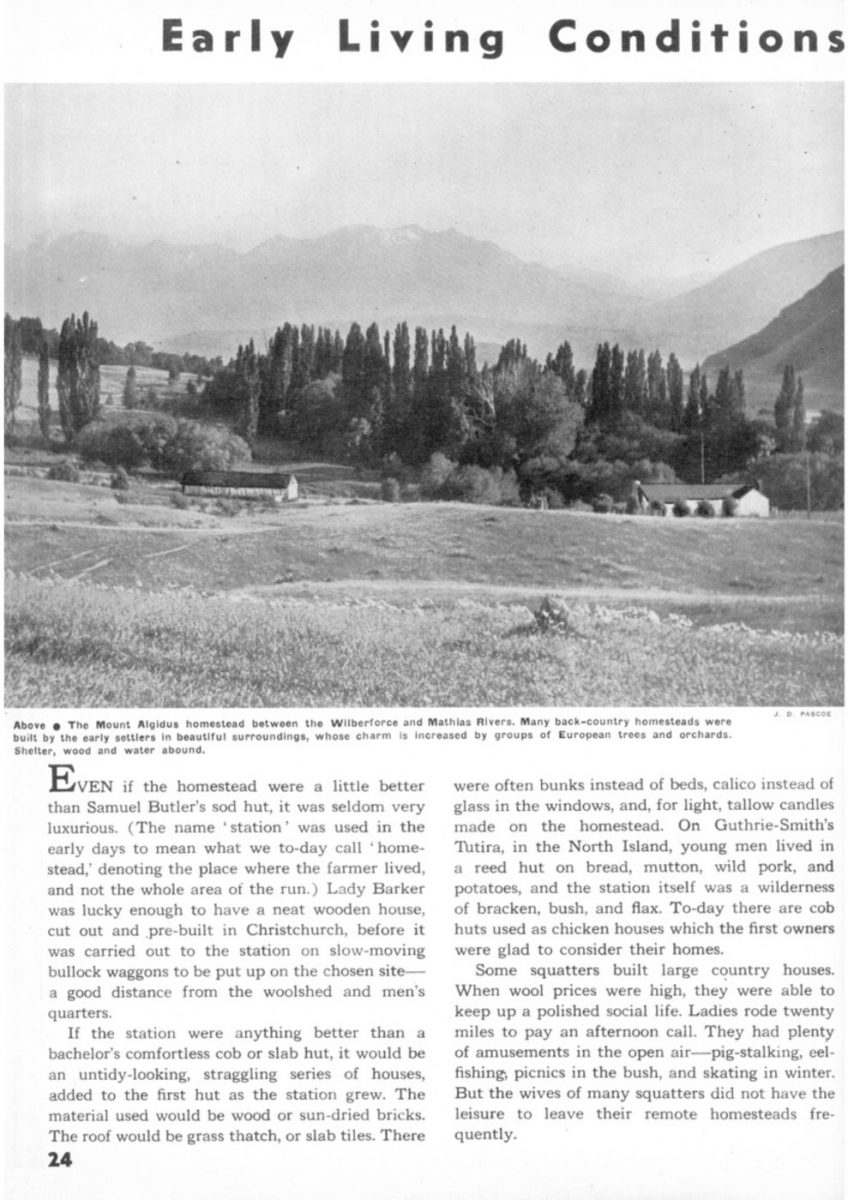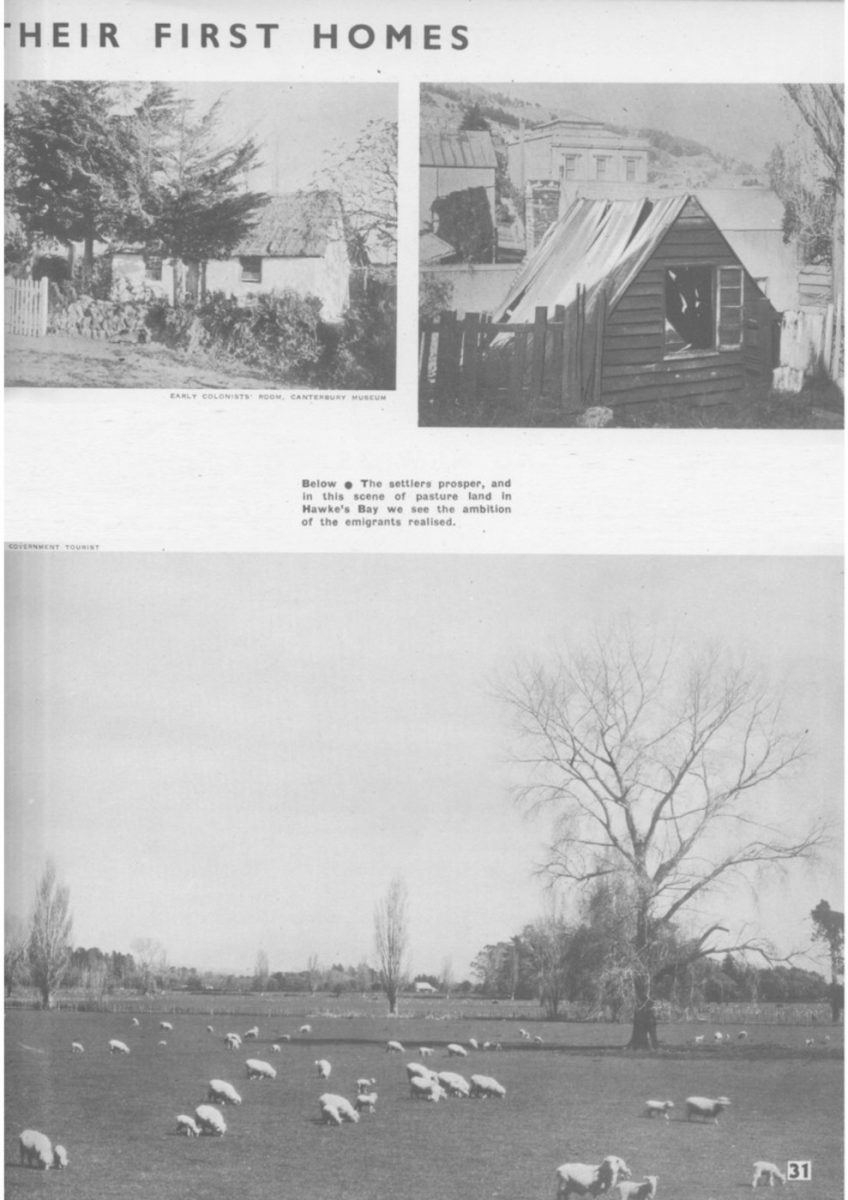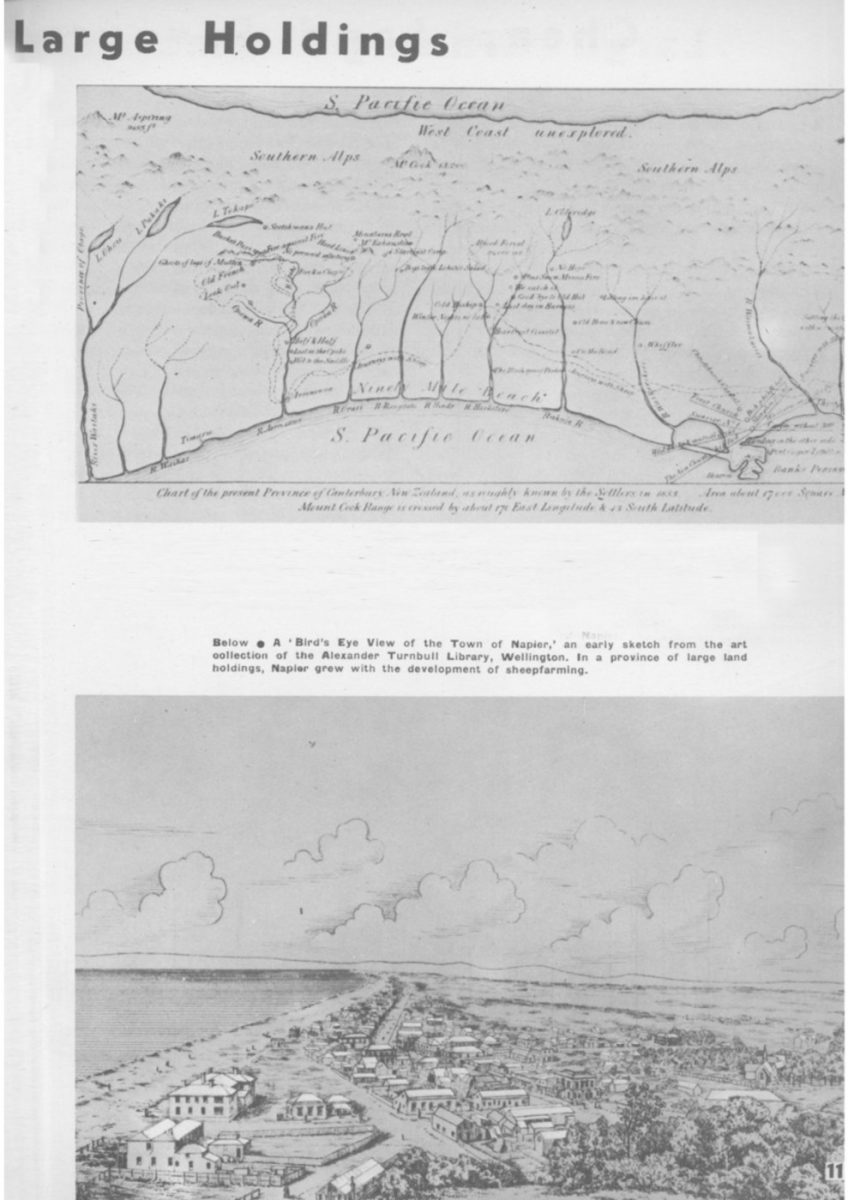- Home
- Collections
- Books
- Making New Zealand – Pictorial Surveys of a Century
Making New Zealand – Pictorial Surveys of a Century
[…] On Guthrie-Smith’s Tutira, in the North Island, young men lived in a reed hut on bread, mutton, wild pork, and potatoes, and the station itself was a wilderness of bracken, bush, and flax. To-day there are cob huts used as chicken houses which the first owners were glad to consider their homes. […]

[…] In Hawke’s Bay Nelson brothers in 1882 installed a refrigerating plant at their Tomoana meat works. Later this firm built four other freezing works in different parts of the country. For some years it used a barque fitted with refrigerating machinery at Plymouth as a distributing centre for the West of England.

[…] A regular overland service between Auckland and Napier, using natives on foot, was arranged in 1857, with branches a little later to Tauranga via Tarawera and Maketu, and to Poverty Bay from Napier. […]
In the North Island, more heavily forested than the South, the condition of overland routes at this time is indicated by a statement that the Wellington – Greytown mail service was to be extended to Masterton, with a further extension to Napier as soon as a bridle path was cut through the Forty-mile Bush (between Masterton and Woodville).

Below – The first federation council of the Women’s Institutes Movement in New Zealand. This meeting was held at Rissington, Hawke’s Bay, in 1925. Women’s Institutes and the Women’s Division of the Farmers’ Union do much to provide recreational activities for country women, while similar work is done in the towns by the Townswomen’s Guild.

[…] In the previous year the first tournament played in New Zealand had been conducted by the Hawke’s Bay Lawn Tennis Club of Napier. It was restricted to members of the club, but was so successful that the following year an open tournament was held. They must have been great enthusiasts in Napier in those days, for no flat land was available, and they had to lay out their courts at Farndon, five or six miles distant. In 1886, when a third tournament was held at Farndon, the assembled players, representing the Thorndon, Hawke’s Bay, and Auckland clubs, agreed to call it the ‘Championships of New Zealand.’ At the same time, through the enterprise of J. F. Jardine, secretary of the Hawke’s Bay club, the New Zealand Lawn Tennis Association was formed. The following year the tournament was held at Christchurch. By that time the game was developing rapidly in technique, and the volley, though still considered unsporting in the more conservative circles, was beginning to exert its revolutionary influence.

[…] Rowing has been practised on nearly every New Zealand river and tideway, and some clubs, such as Napier, first established on the Tutaekuri in 1875, have had chequered careers. The original Napier course no longer exists, as the river has been diverted, while the Inner Harbour course, on which the 1908 New Zealand championships were held, was ruined by the 1931 earthquake; but in recent years the sport has been revived on the Ngaruroro River.

[…] there was a growing agitation against ‘speculative teams,’ and a desire for more effective control led to the formation in 1891 of the New Zealand Rugby Union, which was largely a monument to the initiative of E. D. Hoben, of Hawke’s Bay. It adopted black jersey, white pants, and black stockings as the uniform of New Zealand international teams, but this was subsequently changed in favour of the all black outfit which acquired for New Zealand international teams their distinctive name.

[…] Racing began in Hawke’s Bay in the fifties at Waipureku (Clive). An old settler has described one of the earliest of these meetings: ‘the stake money was the accumulated entrance fees and the start was at a walk (and sometimes twenty yards behind the line), my father’s horse was the winner. The Maoris were so enraged that their chief had been beaten that they rode away with the white men’s horses.’ […]

Above – A view of the scarred ranges to the east of Lake Tutira.
J.D. PASCOE
Right – A typical ‘under runner’ or subterranean stream, referred to on the opposite page. The roof of this under runner has given way here and there. Presently the erosion will be more pronounced. The sketch from H. Guthrie-Smith’s ‘Tutira.’

The Vanished Woodland
THE change over the past sixty years in two scenes – one in each Island – will illustrate the unhappy story of native New Zealand. Within the boundaries of Hawke’s Bay there once existed a fine fragment of woodland, typical of the so-called light bush of New Zealand. It contained no single forest tree but was lovely in its ngaio, kowhai, ribbon-wood, mahoe, whau, and rangiora. Within its depths twined and coiled thickets of supplejack. Conspicuously arose tail groups of tree-fern and nikau. From a thousand minute green blossomings each springtime its fragrance was renewed. Its uneven borders furnished shrubs that love fuller light – ramblers and bush-edge plants. This little woodland faced south and east, an island of bright green in sombre seas of bracken. Within its shade two streamlets bubbled over limestone falls and runs, and rested in clear pools. The airs that emanated from its green depths were moist; its damps were the exquisite breathing of the forest. In arid summer heats to lie within its noontide twilight was to realise, with the travellers in desert sands, the shadow of a great rock in a weary land. Sixty years have seen the decline and ruin of this oasis. Another generation will see its absolute disappearance, its entire transformation into turf.
In the beginning decay was slow. Here and there summer firings during gales drove black wedges into its leafy flanks. During winter, when grass was scarce, and during storms cattle penetrated its edges. For forty years, however, there was no very great external change for the worse. Its continuity indeed seemed assured. It was gazetted a reserve. If paper could protect it was safe. In the meantime the blackberry, its bushes at one time to be counted on the fingers, had overrun the district. A palliation for one evil was found in another – the wholesale introduction of goats. Then indeed all was lost. Re-afforestation by seeds ended, saplings were broken down, shrub-growth nibbled, boles barked bare. Simultaneously the bush floor hardened, its loose debris disappeared in rains that ran, not soaked. With scantier leafage dampness exhaled. The exuberance of tree-fern fronds lessened year by year. Grasses intruded, their invasion increasing the perils of fire. Cattle and sheep have followed in the track of goats. Slips have increased. Without one blow of the axe or the sowing of one grain of alien grass the reserve is doomed. […]

Above – The island on Lake Tutira, known to Maori historians as ‘Tauranga-koau.’
J. D. PASCOE
Nature Retaliates
ANOTHER tale of injury to New Zealand can be told of a flax swamp formerly resting on Tutira Lake. Its surface was smooth. As from a blanket, surplus moisture ran off in ooze and percolation. Throughout the massed rhizomes of the flax no sign of a water-course was visible. It was an expanse everywhere capable of supporting the weight of man and horse had its pristine growth of tall flax made penetration possible. In order after rain more quickly to dry this marsh, a drain was cut along one edge and another across the narrow apex. A subsequent step was the lowering of Tutira Lake by fully two feet. It is necessary here to pause and consider the bearings of such an act, the more so as it is but a sample outrage of the kind that has been and is still the bane of New Zealand. Here was a brace of lads – the writer one of the villains of the piece – barely beyond their teens, new to the country they were pleased to honour with their presence, taking it upon themselves to tamper with a notable feature of the landscape.
Later the flax was burnt and the ground surface sown. For several seasons rainfall was normal. Apparently for all time had an extra spread of rye-grass and several hundred sheep been added to the assets of the Dominion. Then, however, happened one of our Hawke’s Bay floods, a couple of feet falling in two days. The drainages that had heretofore appeared so innocuous and proper then took another aspect owing to the lowering of the lake and consequently more violent scour. The streamlet, formerly losing itself in the apex cut, now gutted out its bed to a depth of twenty feet. Exhumed trees and huge root stubs blocked the passage of the main drain. Over the grassed areas not five acres of turf remained; the balance was submerged in mud but in this first great flood fertile mud, drawn from banks of alluvium immediately beneath the hills. A second great deluge into the deepened streamlet’s course drew down great slices of worthless slope. In 1938, when nearly three feet fell in four days, a third of the swamp was covered with poor sand from one to six feet in depth.
Left – The waterfall outlet of Lake Tutira, which is rapidly receding towards the lake.
J. D. PASCOE

Non-commercial use

This work is licensed under a Attribution-NonCommercial 3.0 New Zealand (CC BY-NC 3.0 NZ).
Commercial Use
Please contact us for information about using this material commercially.Can you help?
The Hawke's Bay Knowledge Bank relies on donations to make this material available. Please consider making a donation towards preserving our local history.
Visit our donations page for more information.
Description
Two volumes, sections 1-15 in first volume, 16-30 in second. 23 x 30 x cm
Only sections relating to Hawke’s Bay have been included
Tags
Format of the original
Book hardbackDate published
1940Creator / Author
- J D Pascoe
- E A Williams
Publisher
New Zealand Department of Internal AffairsPeople
- H Guthrie-Smith
- E D Hoben
- J F Jardine
- E A Williams
- L G Williams





























Do you know something about this record?
Please note we cannot verify the accuracy of any information posted by the community.